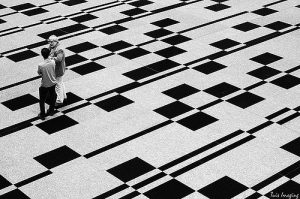Media and place in revolutionary Egypt

Dissertation about information activism and journalism presented by Nina Grønlykke Mollerup at Ørecomm explores media as place-making and what it entails.
“For Aya and Yasmina with the hope that their Egypt will be different.”
This is how Nina Grønlykke Mollerup begins her dissertation. This research is a result of extensive fieldwork and stays both in Cairo and other places. The researcher claims that too much attention has been paid to Tahrir Square when writing about the revolution. However, such focus does not help her understand the transformations she experienced. Small places, the researcher states, could be “more revealing”. Thus, her ethnographic fieldwork takes readers to activist offices, offices of news media corporations, to minor street protests in Cairo and beyond. Ørecomm highlights a few excerpts from the dissertation that makes readers explore how information activism and journalism occurred out in the world among people in Egypt.
“Information activists are people who systematically work to inspire change by producing information and sharing knowledge,” writes Nina Mollerup. And even though she found their practices and goals similar to those of journalists, she saw a significant difference in their epistemologies. Information activists argued that they were able to know about the events they covered because of proximity and participation, whereas journalists argued that they were able to know based on their distance and lack of participation.
Disconnected vs. connected
How is violence related to media? “When information activists ‘go online’ to tweet about violence at a street protest, it does not remove them from the violence. Our engagement with media, whether digital or not, remains intrinsically bound up with our being in places, which occur in the phenomenological world.”
Media could not be detached from places as digital media use does not detach one from violence.
“I do not understand media as existing devoid of places. Rather, media always occur in places with screens, walls, air, and much more. As they occur in places, they make places and are made by places,” states Nina Mollerup in her dissertation. Furthermore, she argues that media occur not only in places, but across places when, for instance, people in and outside of Egypt see images of violence tweeted or when media researchers see these images on their screens. In her paper Nina Mollerup does not disconnect materiality from immateriality. She states that “digital media do not cease to have materiality as they move with shifting forms”.
Presence & interrelation
Materiality and presence are studied in the dissertation with identification of three important aspects. These are ‘co-location’, ‘the presence of there here’ and ‘our presence there’. Nina Mollerup argues that this triad is the foundation of so called ‘thick presence’. Thick presence consists of interaction and participation. These are actions that anthropologists have been doing so far. Yet thick presence puts emphasis on the fact that relevant presence is more significant for ethnographer than co-location.
Furthermore, communication practices by no means can be detached from one another. They are all parts of a bigger picture, nurturing change through various channels. Nina Mollerup describes it through No to Military Trials for Civilians campaign. Each communicative practice influences and facilitates other practices and communicative infrastructures that they enable. She states that they are all an “organic, closely interrelated and continually evolving mix of writing tweets, talking on phones, talking in tents, recording and uploading videos to YouTube and much more”.
To read the whole paper please visit academia.edu.
Photo: Mosireen (2011). Licensed under CC BY-NC-SA 2.0.
 New PhD opportunities at the University of Leicester
New PhD opportunities at the University of Leicester Call for Abstracts: New Directions in Media, Communication and Sociology (NDiMS) Conference
Call for Abstracts: New Directions in Media, Communication and Sociology (NDiMS) Conference Ørecomm Team to Gather at the University of Coimbra
Ørecomm Team to Gather at the University of Coimbra “Communication and Social Change – A Citizen Perspective” Published
“Communication and Social Change – A Citizen Perspective” Published C4D Network to Sum Up Global Communication for Development Practice
C4D Network to Sum Up Global Communication for Development Practice Entering Media and Communication into Development Conferences?
Entering Media and Communication into Development Conferences? IAMCR Conference 2016: Communication for Development Highlights
IAMCR Conference 2016: Communication for Development Highlights Glocal Classroom Revisited – Storytelling & Social Change Leicester-Malmö
Glocal Classroom Revisited – Storytelling & Social Change Leicester-Malmö I EvalComDev International Conference: Call for Papers
I EvalComDev International Conference: Call for Papers Looking for Media and Communication in Development Conferences: Devres 2016
Looking for Media and Communication in Development Conferences: Devres 2016